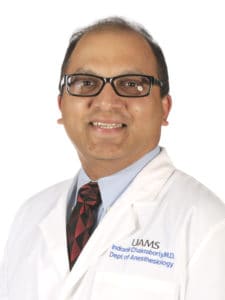A fourth-year anesthesiology resident and neuroanesthesiology professor at UAMS presented a poster on the effects of two popular anesthesiology drugs on stroke patients at the Society for Neuroscience in Anesthesiology and Critical Care (SNACC) virtual annual meeting in September.

Resident Stephanie Kierstead, M.D., and Indranil Chakraborty, M.D., professor and director of the Division of Neuroanesthesiology, authored the study, “Comparative Evaluation of Incidence of Post-Induction Hypotension Using Propofol Vs Etomidate in Cases of Acute Ischemic Stroke Undergoing Endovascular Thrombectomy Under General Anesthesia at UAMS: A Retrospective Chart Review,” for presentation at that Sept. 13 conference.
The retrospective study used medical data for patients with acute ischemic stroke at UAMS between January 2018 and October 2019 to see if there was any difference in patient outcomes between patients who received the drugs propofol and etomidate for induction of general anesthesia. Specifically, they were looking at hypotension, or lowering of blood pressure.
“UAMS is a Level 1 trauma center and is nationally certified by The Joint Commission as a Comprehensive Stroke Center,” Chakraborty said. “Constantly working to improve stroke care is important because stroke is the fifth highest cause of death in the United States, and with the COVID-19 pandemic, there are reports that stroke incidence may be on the rise.
“Over the last five years, research has shown the importance of blood pressure control in the overall outcome in stroke patients,” Chakraborty said. “It is tied to the amount of blood flow to the brain that occurs. Blood pressure control is emerging to be a major determinant of the long-term patient outcomes for stroke patients.”

Chakraborty and Kierstead hypothesized that etomidate would be associated with more stable blood pressure in stroke patients, as previous studies on other types of patients have found that to be the case.
The study included 55 patients who were over 18, were not intubated when they arrived at UAMS, and who only received one of the drugs and not both. The researchers used the initial vitals from arrival at UAMS to establish a baseline blood pressure to compare with their lowest blood pressure within 30 minutes after inducing anesthesia.
“What we found was interesting: both of the groups had significant hypotension, which we defined as a fall in blood pressure by more than 20% compared to baseline,” Kierstead said. “The magnitude of hypotension was less in the etomidate group compared to the propofol group.”
The etomidate group on average experienced a 21% drop in blood pressure, while the drop was nearly 31% in the propofol group.
Chakraborty said the study also served as a preliminary quality control project on UAMS’ own protocols and procedures.
“Given the mounting evidence about blood pressure and stroke, combined with previous studies in other patient populations about etomidate, we switched our guidelines a couple of years back to etomidate for stoke patients,” Chakraborty said. “We are one of the few institutions in the country to use etomidate as a part of our stroke guidelines. We’re trying to stay on the leading edge of the science.”
Kierstead said the research experience as part of her residency has been valuable. After she matriculates from the program in 2021, she is considering an obstetric fellowship and hopes to enter private practice.
“Just the process of doing research is going to make me a better clinician in the future, to see how the process works and to stay attuned to practicing medicine on the forefront of knowledge and exploring what will be best for my patients,” Kierstead said.
Chakraborty said he thinks it’s important for all anesthesiology residents to gain experience with treating and understanding stroke.
“Many career paths in anesthesia are likely to put you in contact with stroke or recent stroke,” Chakraborty said. “I think every resident should have a good experience with ischemic stroke patients which constitute 87% of all stroke patients in U.S., and we are lucky to have a Level 1 stroke center right here in Central Arkansas. As a residency program, we try to take advantage of that to make sure our residents are prepared, and we’re constantly improving care, conducting research, making changes and publishing our findings for the rest of the world community, so we can all work together to improve treatment.”
